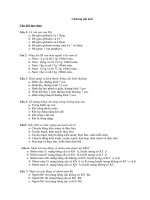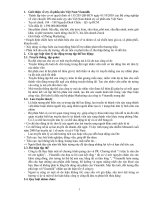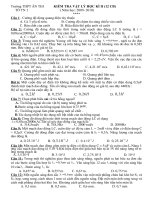tài liệu – page 2 – tâm lý học vb2k04
Bạn đang xem bản rút gọn của tài liệu. Xem và tải ngay bản đầy đủ của tài liệu tại đây (476.99 KB, 10 trang )
<span class='text_page_counter'>(1)</span><div class='page_container' data-page=1>
Structuralism
• <sub>seeks to analyze the adult mind (the total sum of </sub>
experience from birth to the present) in terms of
the simplest definable components and then to
find how these components fit together to form
more complex experiences as well as how they
correlated to physical events. To do this,
</div>
<span class='text_page_counter'>(2)</span><div class='page_container' data-page=2>
Introspection
• <sub>literally means 'looking within', to try to describe </sub>
a person's memory, perceptions, cognitive
processes, and/or motivations.
• <sub>three types of mental elements constituting </sub>
conscious experience: Sensations (elements of
perceptions), Images (elements of ideas), and
affections (elements of emotions).
• <sub>These elements could be broken down into their </sub>
respective properties, which he determined were
quality, intensity, duration, clearness, and
</div>
<span class='text_page_counter'>(3)</span><div class='page_container' data-page=3>
Functionalism
• <sub>states that mental states (beliefs, desires, being </sub>
in pain, etc.) are constituted solely by their
functional role – that is, they have causal
relations to other mental states, numerous
sensory inputs, and behavioral outputs.
• <sub>mental states are the corresponding functional </sub>
role, mental states can be sufficiently explained
without taking into account the underlying
</div>
<span class='text_page_counter'>(4)</span><div class='page_container' data-page=4>
Behaviorism
• <sub>It assumes that all behaviors are either reflexes </sub>
produced by a response to certain stimuli in the
environment, or a consequence of that
individual's history, including especially
reinforcement and punishment, together with the
individual's current motivational state and
controlling stimuli.
• <sub>Behaviorism focuses on one particular view of </sub>
learning: a change in external behavior achieved
through using reinforcement and repetition to
</div>
<span class='text_page_counter'>(5)</span><div class='page_container' data-page=5>
Main versions
• <sub>Methodological behaviorism: Watson's </sub>
behaviorism states that only public events
(behaviors of an individual) can be objectively
observed, and that therefore private events
(thoughts and feelings) should be ignored
• <sub>Radical behaviorism: Skinner's behaviorism </sub>
theorizes that processes within the organism
should be acknowledged, particularly the
presence of private events (such as thoughts and
feelings), and suggests that environmental
</div>
<span class='text_page_counter'>(6)</span><div class='page_container' data-page=6>
Cognitivism
• <sub>Cognitive theory mainly stresses the acquisition </sub>
of knowledge and growth of the mental structure.
• <sub>The process of assimilating and expanding our </sub>
intellectual horizon is termed as cognitive
development.
• <sub>In cognitive theories not only the environmental </sub>
factors and instructional components play an
</div>
<span class='text_page_counter'>(7)</span><div class='page_container' data-page=7>
Differences
• <sub>A behaviorist uses feedback (reinforcement) to </sub>
change the behavior in the desired direction, while
the cognitivist uses the feedback for guiding and
supporting the accurate mental connections
• <sub>Cognitivists examine the learner's 'how to design' </sub>
instruction that it can be assimilated . (i. e ., what
about the learners existing mental structures?) In
contrast, the behaviorists looks at learners how to
determine where the lesson should begin ( i. e., At
what level the learners are performing
</div>
<span class='text_page_counter'>(8)</span><div class='page_container' data-page=8>
Humanistic
• <sub>emphasizes individuals' inherent drive towards </sub>
self-actualization, the process of realizing and
expressing one's own capabilities and creativity.
• <sub>It adopts a holistic approach to human existence </sub>
and pays special attention to such phenomena as
creativity, free will, and positive human potential.
It encourages viewing ourselves as a "whole
person" greater than the sum of our parts and
encourages self exploration rather than the study
of behavior in other people. Humanistic
</div>
<span class='text_page_counter'>(9)</span><div class='page_container' data-page=9>
Humanistic Therapy
• <sub>encourages a self-awareness and mindfulness </sub>
that helps the client change their state of mind
and behaviour from one set of reactions to a
healthier one with more productive
self-awareness and thoughtful actions. Essentially,
this approach allows the merging of mindfulness
and behavioural therapy, with positive social
</div>
<span class='text_page_counter'>(10)</span><div class='page_container' data-page=10>
Principles of Humanistic
• Human beings, as human, supersede the sum of
their parts. They cannot be reduced to components.
• Human beings have their existence in a uniquely
human context, as well as in a cosmic ecology.
• <sub>Human beings are aware and are aware of being </sub>
aware - i.e., they are conscious. Human
consciousness always includes an awareness of
oneself in the context of other people.
• Human beings have the ability to make choices and
therefore have responsibility.
</div>
<!--links-->









